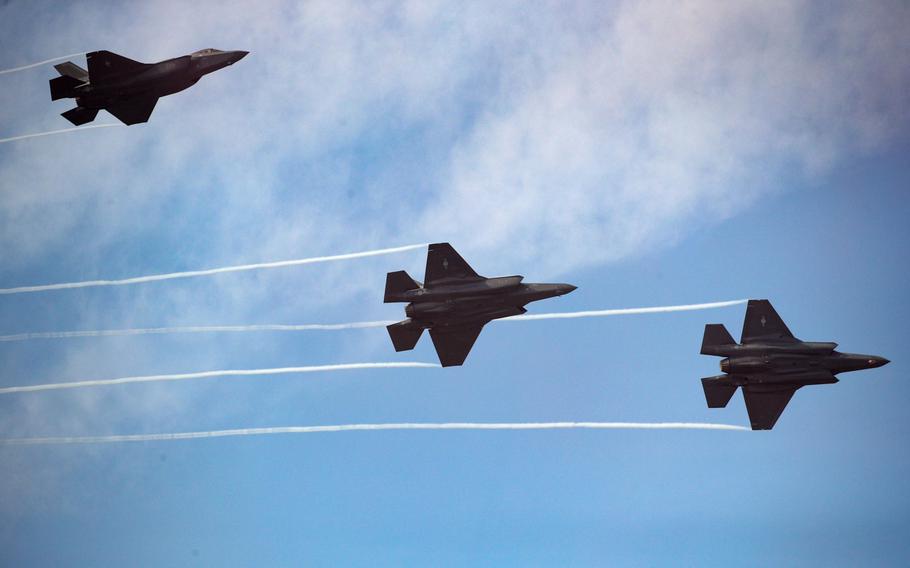
South Korean Air Force F-35 Lightning II fighter jets, manufactured by Lockheed Martin Corp., at the Seoul International Aerospace & Defense Exhibition (ADEX) at Seoul Air Base in Seongnam, South Korea, on Oct. 14, 2019. (SeongJoon Cho/Bloomberg)
A shortage of spare engines may leave some F-35s grounded because it’s taking longer than planned to repair a key component for the U.S.’s costliest warplane, according to congressional auditors.
“Inadequate maintenance depot capacity leading to a shortage of operating” engines has “grounded F-35s more often and for longer time periods than expected,” the Government Accountability Office said in a new report Tuesday.
Much of the issue stems from the Pentagon’s failure to develop an adequate strategy for sustaining the engine, including providing sufficient depot repair capability as production continues, the GAO said. Engines for the plane that’s built by Lockheed Martin are provided by Raytheon Technologies Corp.’s Pratt & Whitney unit.
So far, 820 F-35s have been delivered worldwide out of a potential 3,000 for the U.S. and partner nations. After years of talks, the Pentagon announced Monday evening that it reached agreement with Lockheed on the next three-year contract for 375 more of the advanced fighters.
The GAO report expands on public testimony the agency gave to a House panel in April. Its warning of the need to stem a current, and possibly expanding, shortage of ready engines contrasts with positive publicity that the F-35 is receiving as it flies patrols over Eastern Europe after Russia’s invasion of Ukraine. Finland, Switzerland, Germany and Greece are the latest overseas customers for the aircraft, and South Korea has signaled it wants more jets.
The engine repair issue — and its ramifications for readiness — are a case study in why the Pentagon is struggling to reduce the estimated $1.3 trillion cost to operate and sustain the planes over a 66-year projected lifespan. Engine sustainment costs are already projected to hit $1 billion annually by 2028, up from $315 million last year, as aircraft quantities, flying hours and scheduled maintenance increase, the GAO said.
Since the beginning of 2020, “an increasing number of F-35 aircraft have not been able to fly due to the lack of an operating engine,” the auditors said. “Almost all of the aircraft affected” are operated by the Air Force, the largest F-35 customer, with 348 of its planned 1,763 planes in its inventory. The 2,456 planes projected for the U.S. also include versions for the Marine Corps and Navy.
For example, in August 2021, the Air Force had 35 aircraft unable to fly because they didn’t have an operating engine, according to service officials. It had taken delivery of about 283 by then. In February, the latest data period cited, about 36 jets had no engines. The major impediment is repairs to the power module, one of five in the engine, which is designated F-135, that’s key to generating thrust. It’s taking longer to repair, and the Pentagon lacks enough spare engines, the GAO said.
The Defense Department’s F-35 program office “is aware of the challenge the program faces related to engine sustainment” and agreed with GAO’s recommendation that it needs to continue to review and revise support strategy for the engine, Lt. Gen. Mike Schmidt, the F-35 program manager, said in a statement.
The engine removals aren’t the result of defective, flawed or substandard material, the F-35 program office said in a statement earlier this year. One major cause: A coating on the engine’s high-pressure turbine blades has been “degrading faster than anticipated” as it flew in sandy environments.
Since the fall of 2020, the F-35 Joint Program Office and Pratt & Whitney “have taken actions and have plans to take additional actions to increase depot repair capacity to meet current and future engine maintenance need” and “these efforts have begun to improve depot capacity” and resulted in improved projections of engine availability, the GAO said.
The time to repair power modules dropped to 119 days in January, from 207 days in October 2020. Starting in early 2020, all new engines and those repaired in depots have blades with a new coating “that has demonstrated greatly increased performance,” the program office said.
Still, “significant risks remain that will require DoD and Pratt & Whitney sustained management attention,” GAO said.
The two sides have had a disagreement since at least 2019 over how much money is needed for spare parts funds to repair engine modules, for example.
“Pratt & Whitney stated the difference was over $400 million and that it will negatively affect the program,” the GAO said, while the Pentagon F-35 program office “stated that this gap was about $170 million.”
Schmidt, the program manager, said his office has also agreed with the GAO’s recommendation that it should develop with Pratt & Whitney a common model for forecasting spare parts needs.
Bloomberg’s Ryan Beene contributed to this report.